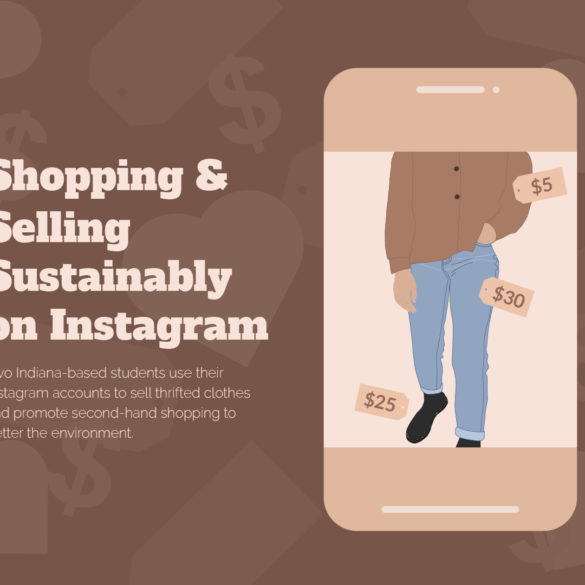Two Indiana-based students use their Instagram accounts to sell thrifted clothes and promote second-hand shopping to better the environment.
Once a week, Julia Haslett pulls into the parking lot of a Goodwill Store at its 10 a.m. opening time to shop for her more than 3,000 Instagram followers. Hours later, she returns home to sort out the clothes she bought — sweaters, dresses, T-shirts, cardigans, blouses and bodysuits from brands such as Free People, Princess Polly, Forever 21 and more.
Julia, a senior at Purdue University Fort Wayne, is part of the Instagram thrifting community where she runs her account, @thrift.n.boujee. When she started her account in October 2019, she sold items she no longer wore from her closet. As she began thrifting more and more, she developed her own personal style. Now, Julia visits Plato’s Closet, Clothes Mentor, Facebook Marketplace, and thrift stores in cities like Carmel, Indiana, to find boutique and higher-end items to sell on her account.
“When I was a teenager, I would shop at Plato’s Closet, and it was heaven,” Julia says. “You had any and everything there that you could find, and it was a little bit of a mix of everything.”
Katie Clamme, a freshman at Indiana University Bloomington, also began her own Instagram thrifting account, @katies_thrifts_, this past summer to sell her old clothes. Katie offers vintage and late 90s/early 2000s clothes on her account to more than 3,800 followers.
“I will admit I used to get really, really frustrated going to thrift stores because I would never find anything,” Katie says. “I didn’t have the patience for it, and I would walk in and be so overwhelmed … Once I kept going over and over again, I figured out how to find things that I like. It mostly takes a lot of patience and a lot of time. If you’re going to the store, and you want to find things, you just have to go in with an open mind and know that it’s going to take time to look through everything.”
One of the core values of Julia and Katie’s accounts is the importance of shopping sustainably. Katie says she never buys any new clothes — she always thrifts so she doesn’t contribute to fast fashion.
The equivalent of one garbage truck of textiles is landfilled or incinerated every second, according to thredUP, an online consignment and thrift store that aims to inspire a new generation of shoppers to think secondhand first. When someone buys secondhand clothes instead of shopping at retail stores, Julia says, they are reusing the fabric that somebody else already made, so these clothes don’t go into a landfill. This prevents landfills from overflowing into our living space.
“[Fast fashion] is a really good example of how consumeristic our culture is,” Katie says. “We always find excuses to buy new clothes, like ‘Oh, I need a new dress for this event, or ‘I need to go back-to-school shopping because I want to have a new wardrobe for school.’ A lot of people who don’t have enough money to buy more ethical brands, they go to SHEIN or ZAFUL, and it’s really cheap — almost as cheap as going to a thrift store. You get a ton of new stuff for barely any money.
“But, the problem with that is the people who make those clothes get paid barely anything. A lot of them are children. So, it’s just not the most humane way to go. Also, a lot of that clothing is not good quality, and it ends up in the trash anyway. [These companies] make so much stuff that some of it just gets thrown away or burned. It’s really bad for the environment.”
Julia and Katies’s followers will bid on the clothing items they post. 24 hours after the first bid, Julia and Katie direct message the user with the highest bid, and users pay an additional $4-$7 in shipping to receive the item they won. Julia and Katie both post drops once a week so they are consistent and build trust with their followers.
Nataltie Pyles, a freshman at Indiana University Bloomington, is one of Katie’s regular customers. Since meeting Katie through a mutual friend and discovering her thrifting account, Natalie has bought two belts, a pair of shorts, a sweatshirt, a pair of jeans, and a jacket from Katie.
Natalie believes she is helping save the environment by sparing the wasted fabric it would take to create a new shirt or sweater. She typically gets her clothes from Goodwill, Plato’s Closet, or through buying from Instagram accounts, but she purchases her jeans from American Eagle because the brand fits her body the best.
“I think fast fashion is extremely bad for the environment but extremely convenient,” Natalie says. “[American Eagle has] jeans … that make me feel confident without having to look for hours, which is extremely sad but convenient … I always feel better going home from a thrift store than the mall.”
Julia also hosts Instagram Lives with her followers where she bids off clothes in her inventory. She says she had to get comfortable with being vulnerable, so she could stand in front of her camera in her bedroom with nearly 60 viewers watching her.
“I am a one-man band,” Julia says. “Sometimes, it’s my least favorite part, but most of the time, it is my favorite part because I am the marketer. I am the model. I get to do all the things that I’m basically going to school for, which is communications and business. I love that I can be my own boss. I make my own schedule. I am as creative as I want to be.”
“It’s genuinely me, and I get to present myself in the way that I want to,” she adds.
Julia and Katie believe what sets their accounts apart from others is they pick out and sell items they would wear themselves. It is crucial to develop a personal style and aesthetic to her account’s feed, Julia says, because then her followers will recognize her own way of thrifting and the kind of clothes she offers.
“I cater more to my individual style than to just what I think is popular, and I think that has also helped [my account] grow,” Katie says. “Some accounts, I feel like a lot of what they’re trying to do is they’re just trying to sell clothes. A lot of it isn’t the best pieces — it’s just things that they think that they can make some money on. When your followers think that you’re just trying to make money, then they’re not really going to want to buy from you because that shouldn’t be the sole purpose of your account.”
Katie has experienced a negative attitude toward thrift accounts, she says, as some users believe accounts take advantage of their customers by charging a higher dollar amount than what they had paid for the thrifted item.
“My shop is for people who don’t want to go to the thrift store and spend hours looking through the aisles, people who don’t have that time,” Katie says. “Not everybody has that convenience of being able to go to the thrift store every other day and look through all the aisles and be there for hours. So, you’re paying for the convenience of having sorted through, picked out, high quality clothing from the thrift store and being able to purchase it without having to dig for it.
“When I find a really unique sweatshirt, and I charge $30 for it, you’re not just paying the $5 that the sweatshirt cost me. I’ve spent hours looking for that, and I’ve spent time taking the pictures. I spend time packaging it. When I make that profit off it, you have to think that I put in these hours, just like you would a normal job. It’s not a quick and easy process. I think a lot of people assume that it’s really easy when it’s not.”
To show her customers how special they are to her and how dedicated she is to her work, Katie wraps each package’s items in colorful yarn and adds a handwritten thank you note. About half of her sales are from recurring customers, she says, so it’s important for her to have and maintain a good relationship with them.
As Julia interacts with her followers and other accounts in the online thrifting community, she has gained many internet friends and will even drive two hours to meet another Indiana-based Instagram thrifter.
“You hear gamers talk about having gaming friends, and they have gaming conventions, and I’m like, ‘Oh, that’s kind of different, you know?’” Julia says. “But then, there’s a community of thrifters, and we have thrift-cons … It’s not only reassuring, but it fills that spot you need. Everybody needs friends. Right now, just most of mine are on the Internet. I get to hang out with my friends, and it just feels good, especially to have that support.”












